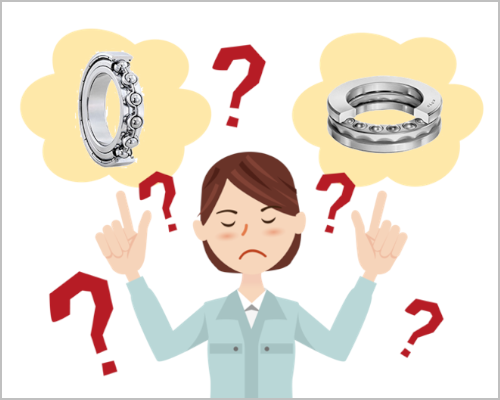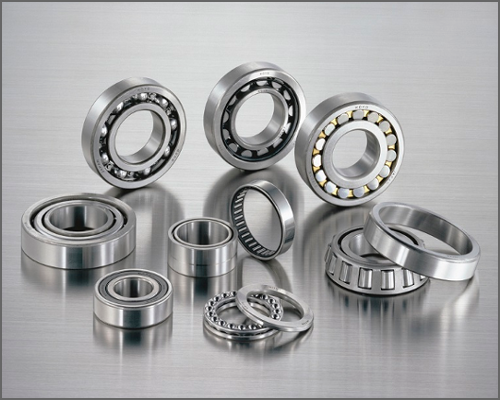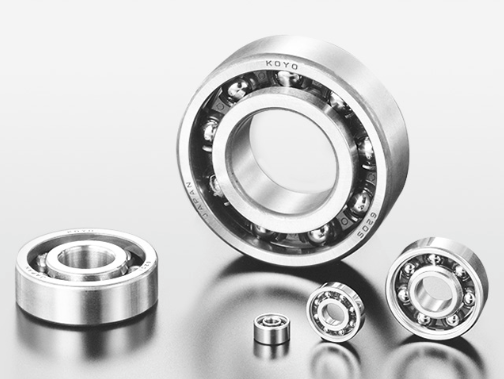Bearing Trivia
Bearing Trivia for Beginners 2: "Bearing Materials (Part 1: General Information)"
- Bearing Trivia for Beginner
To the readers of Bearing Trivia,
Thank you very much for your continued interest in our Bearing Trivia columns.
Your Bearing Trivia reporter, Mr. X here!
Continuing on from the last part, in Bearing Trivia for Beginners 2, we will introduce you to bearing materials.

1. Bearing materials
A bearing is a component that rotates smoothly while supporting a load (force) applied to a machine.
When the bearing that supports the load rotates, the load is repeatedly applied to the raceway surfaces of the inner and outer rings each time rolling elements (balls or rollers) pass (see Figure 1).
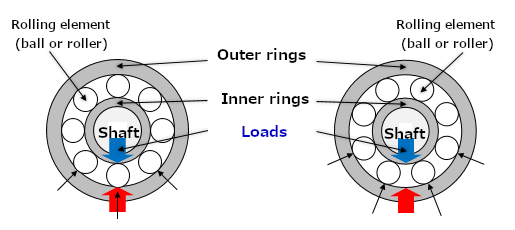
Fig. 1: Repeated loads applied to bearings
Due to this repeated load, high pressure is generated on the raceway surfaces of the inner and outer rings that are in contact with the rolling surfaces of the rolling elements.
Consequently, material flakes from the surfaces of the bearing rings or rolling elements by fatigue arising from repeated contact stress. This is called "flaking" or "spalling" (see Figure 2).
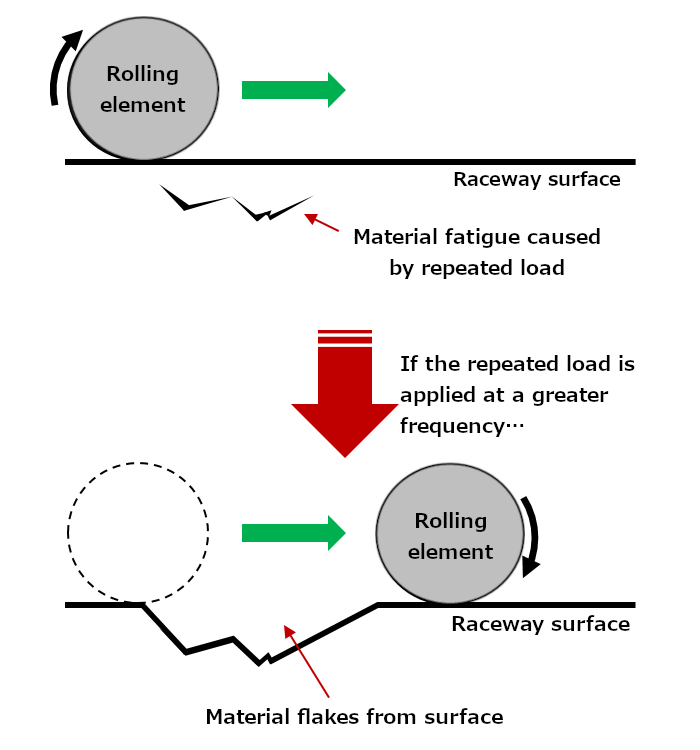
Fig. 2: Fatigue on the raceway surface
For more details, see:
How to Select the Right Bearing (Part 3): Bearing dimensions and service life
For this reason, bearing materials are required to have certain properties such as being resistant to rolling fatigue and being able to withstand harsh operating conditions, as shown in Table 1.
Table 1 Required characteristics for bearing materials
| No. |
Required characteristic |
Bearing component | ||
|---|---|---|---|---|
|
Bearing ring*1 |
Rolling element (ball, roller) |
Cage |
||
| 1 |
Can withstand high pressure on the contact surface |
✔ | ✔ | |
| 2 |
Is resistant to rolling fatigue |
✔ | ✔ | |
| 3 |
Can achieve a high level of hardness |
✔ | ✔ | |
| 4 |
Is resistant to wear |
✔ | ✔ | ✔ |
| 5 |
Can withstand impact |
✔ | ✔ | ✔ |
| 6 |
Has stable dimensions |
✔ | ✔ | ✔ |
*1 The different types of bearing rings are shown below (see Figure 3).
- For radial bearings: inner ring and outer ring
- For thrust bearings: shaft race and housing race
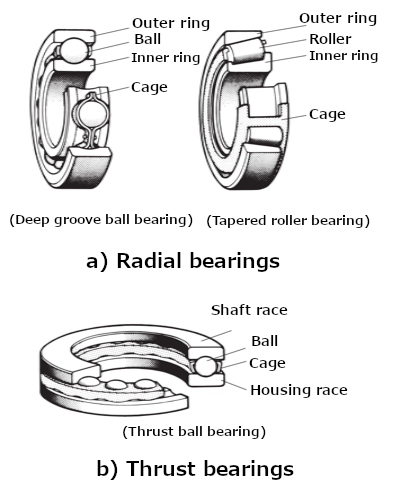
Fig. 3: Bearing structure
2. Bearing ring and rolling element materials
For the material used in bearing rings and rolling elements, generally high carbon chromium bearing steel is used. Case carburizing steel is used in cases where a heavy impact will be applied.
Note that materials for bearings to be used in special environments such as corrosive, vacuum, clean, or high-temperature environments will be introduced in Part 2."
1) High carbon chromium bearing steel
Table 2 shows the chemical components of high carbon chromium bearing steel.
Table 2: Chemical components of high carbon chromium bearing steel
|
Standard*2 |
Code |
Chemical composition (as a percentage; representative value) |
||||
|---|---|---|---|---|---|---|
|
C Carbon |
Si Silicon |
Mn Manganese |
Cr Chromium |
Mo Molybdenum |
||
| JIS G 4805 | SUJ 2 | 0.95~1.10 | 0.15~0.35 | 0.5 or less | 1.30~1.60 | 0.08 or less |
| SUJ 3 | 0.95~1.10 | 0.40~0.70 | 0.90~1.15 | 0.90~1.20 | 0.08 or less | |
| SUJ 5 | 0.95~1.10 | 0.40~0.70 | 0.90~1.15 | 0.90~1.20 | 0.10~0.25 | |
| SAE J 404 | 52100 | 0.98~1.10 | 0.15~0.35 | 0.25~0.45 | 1.30~1.60 | 0.06 or less |
Remark
*2 Industrial standards published by JIS (Japanese Industrial Standards) and SAE (Society of Automotive Engineers) respectively.
The high carbon chromium bearing steel that is most widely used in bearings is SUJ2. SUJ3 contains a relatively large amount of manganese (Mn) and excellent hardenability during heat treatment, so it is used in relatively thick-section bearings. SUJ5 has molybdenum (Mo) added to SUJ3, and has even better hardenability.
For this reason, small and medium bearings use SUJ2 or SUJ3, while large and ultra large bearings with thicker cross-sections use SUJ5.
2) Carburizing steel (case hardened steel)
Carburizing steel is used for bearings on which a large impact will be applied, such as those used in the roll necks of rolling mills or in construction equipment.
What's great about bearings that use case carburizing steel is that they have hard surfaces and soft inside sections (see Figure 4), so the propagation of cracks that occurs on the surface due to fatigue or friction is slow to progress inward, and the bearing is therefore resistant to damage.
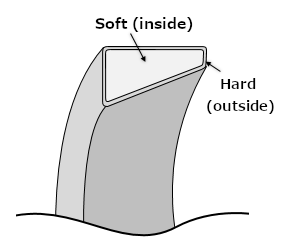
Fig. 4: A bearing that uses carburizing steel (tapered roller bearing; outer ring)
Table 3 shows the chemical components of the major carburizing steel materials.
Table 3: Chemical components of major carburizing steel materials
|
Standard*3 |
Symbol |
Chemical composition (as a percentage; representative value) |
|||||
|---|---|---|---|---|---|---|---|
|
C Carbon |
Si Silicon |
Mn Manganese |
Ni Nickel |
Cr Chromium |
Mo Molybdenum |
||
| JIS G 4053 | SCr 420 | 0.18~0.23 | 0.15~0.35 | 0.60~0.85 | ― | 0.90~1.2 | ― |
| SCM 420 | 0.18~0.23 | 0.15~0.35 | 0.60~0.85 | ― | 0.90~1.2 | 0.15~0.3 | |
| SNCM 815 | 0.12~0.18 | 0.15~0.35 | 0.30~0.6 | 4.00~4.5 | 0.70~1 | 0.15~0.3 | |
| SAE J 404 | 5120 | 0.17~0.22 | 0.15~0.35 | 0.70~0.9 | ― | 0.70~0.9 | ― |
| 8620 | 0.18~0.23 | 0.15~0.35 | 0.70~0.9 | 0.40~0.7 | 0.40~0.6 | 0.15~0.25 | |
| 4320 | 0.17~0.22 | 0.15~0.3 | 0.45~0.65 | 1.65~2 | 0.40~0.6 | 0.20~0.3 | |
Remark
*3 Industrial standards published by JIS (Japanese Industrial Standards) and SAE (Society of Automotive Engineers) respectively.
For more details, see:
JTEKT material codes for case carburizing steel
3) Limiting the reduction in bearing service life in dirty oil
If a bearing is used with oil lubrication, such as in a gear box, hard contaminants such as dust from wear can get mixed in with the lubricating oil. If those hard contaminants get caught in between the raceway surfaces of the inner and outer rings that come in contact with the rolling surfaces of the rolling elements, plastic deformations (indentations) occur on the surfaces, which in turn results in flaking, and a reduction in the bearing service life (see Figure 5).
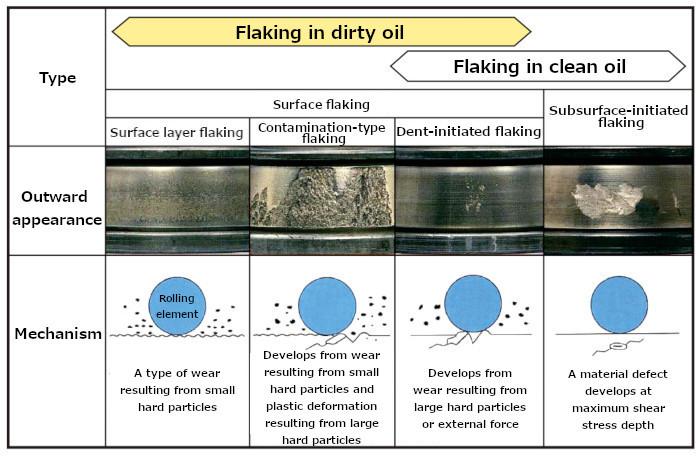
Fig. 5: The types and mechanisms of flaking
In order to ameliorate the effects of indentations caused by contaminants, here at JTEKT we provide bearings that we have subjected to special heat treatment (namely the SH Bearing, the KE Bearing, and the NK Bearing).
For more details, see:
Basic Bearing Knowledge: Bearing ring and rolling element materials
SH bearing、KE bearing、NK bearing
SH Bearing, KE Bearing, and NK Bearing
3. Cage materials
Cages are used to keep the rolling elements separated from each other, which allows them to roll smoothly.
The cage comes in contact with the rolling elements or bearing rings by sliding, and, when a force is applied to the bearing or the rotation is accelerated or decelerated, the rolling elements exert a force by pushing or pulling on the cage (see Figure 6).
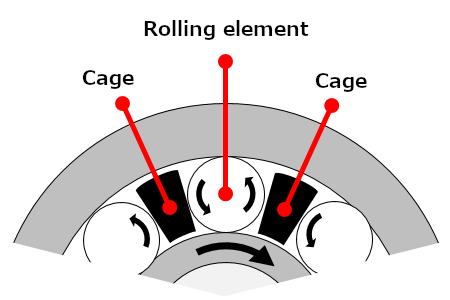
Fig. 6: The function of the cage
For more details, see:
What's the Structure of the Bearing? The role of the structure and parts in reducing friction (Cage)
For the cage, we use the appropriate type and material to suit the specific conditions of the bearing, such as the magnitude of the supporting force or the speed of the rotation.
1) Cage types
The major cage types are, as shown in Table 4, pressed cages, machined cages, and resin cages.
Table 4: Major cage types and machining processes
|
Cage type |
Machining process |
Suitable material | |||
|---|---|---|---|---|---|
| Metal |
Resin |
||||
|
Steel sheet |
Carbon steel |
Brass |
|||
|
Pressed cage |
Pressing with a die |
✔ | |||
|
Machined cage |
Machining of metal or resin lumps |
✔ | ✔ | ✔ | |
|
Resin cage |
Machining of resin lumps |
✔ | |||
|
Flowing the resin into a mold for forming (this process is called "molding") |
|||||
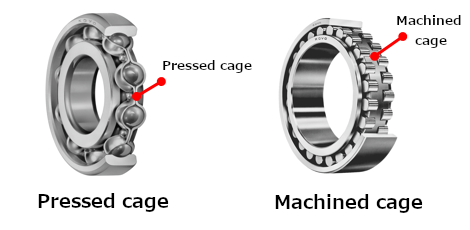 Fig. 7: Machined cages (made with steel plates) and pressed cages (made with brass)
Fig. 7: Machined cages (made with steel plates) and pressed cages (made with brass)
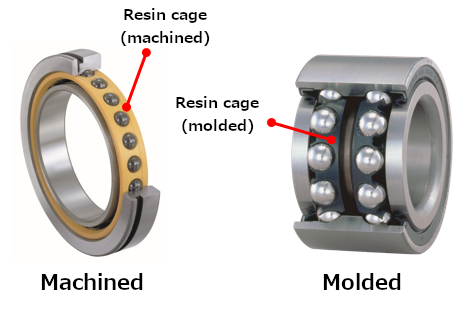 Fig. 8: Resin cages
Fig. 8: Resin cages
2) Metal materials for cages
Tables 5 and 6 show the chemical compositions of the major metal materials for cages.
Table 5: Chemical components of major steel plate materials for pressed cages
|
Standard |
Code |
Chemical composition (as a percentage; representative value) |
|
|---|---|---|---|
|
C Carbon |
Mn Manganese |
||
|
G 3141 (cold-rolled steel sheet) |
SPCC | 0.12 or less | 0.50 or less |
|
G 3131 (hot-rolled mild steel sheet) |
SPHC | 0.15 or less | 0.60 or less |
|
Standard |
Code |
Chemical composition (as a percentage; representative value) |
||||||
|---|---|---|---|---|---|---|---|---|
|
Cu Copper |
Zn Zinc |
Mn Manganese |
Fe Iron |
Al Aluminum |
Sn Tin |
Ni Nickel |
||
| JIS H 3141 | CAC301 | 55~60 | 33~42 | 0.1~0.5 | 0.5~1.5 | 0.5~1.5 | 1 or less | 1 or less |
When a force is applied to the bearing or the rotation is accelerated or decelerated, the rolling elements exert a force by pushing or pulling on the cage. In cases where a heavy force is applied to the cage, a machined cage made with a strong metal material is used. For high-speed rotation, we use a metal material that has a low sliding friction coefficient and is strong but light.
3) Resin materials for cages
There are two processing methods for resin cages: machining and molding.
Table 7 shows the chemical compositions of the major resin materials for cages.
Table 7: Major resin materials for cages
|
Machined resin cages |
Molded resin cages |
|---|---|
|
Phenol resin |
Polyacetal Polyamide (nylon 6.6, nylon 4.6) Polymer containing fluorine |
For more details, see:
Basic Bearing Knowledge: Materials used for cages
JTEKT material codes and shape codes for cages
JTEKT material codes and shape codes for cages
Conclusion
- Bearing materials are required to have certain properties such as being resistant to rolling fatigue and being able to withstand harsh operating conditions.
- For the material used in bearing rings and rolling elements, generally high carbon chromium bearing steel is used, while case carburizing steel is used if a heavy impact is to be applied. In order to ameliorate the effects of indentations caused by contaminants in dirty oil, bearings are sometimes subjected to special heat treatment.
- For the cage, we use the appropriate type and material to suit the bearing usage conditions, such as the magnitude of the supporting force or the speed of the rotation.
Look forward to the next "Bearing Trivia for Beginners: Bearing Materials (Part 2)"!
